Melanesia
Melanesia (UK: /ˌmɛləˈniːziə/, US: /ˌmɛləˈniːʒə/) is a subregion of Oceania in the southwestern Pacific Ocean. It extends from the island of New Guinea in the west to Tonga in the east, and includes the Arafura Sea.
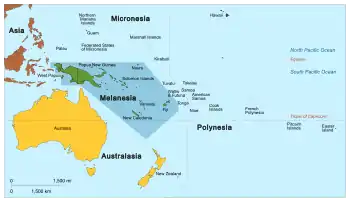
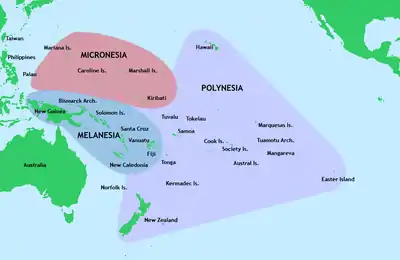
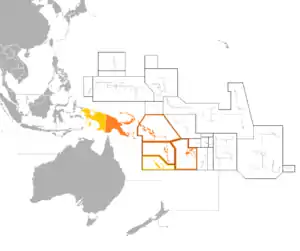
The region includes the four independent countries of Fiji, Vanuatu, the Solomon Islands, and Papua New Guinea. It also includes the French special collectivity of New Caledonia and parts of Indonesia – notably Western New Guinea, which is the Indonesian part of the island of New Guinea. Almost all of the region is in the Southern Hemisphere; only a few small islands that are considered part of Oceania — specifically the northwestern islands of Western New Guinea — lie in the Northern Hemisphere.
The name Melanesia (in French, Mélanésie) was first used in 1832 by French navigator Jules Dumont d'Urville: he coined the three terms Melanesia, Micronesia and Polynesia to designate what he viewed as the three main ethnic and geographical regions forming the Pacific.
Etymology and name ambiguity
The name Melanesia, from Greek μέλας, black, and νῆσος, island, etymologically means "islands of black [people]", in reference to the dark skin of the inhabitants.
The concept among Europeans of Melanesia as a distinct region evolved gradually over time as their expeditions mapped and explored the Pacific. Early European explorers noted the physical differences among groups of Pacific Islanders. In 1756, Charles de Brosses theorized that there was an "old black race" in the Pacific who had been conquered or defeated by the peoples of what is now called Polynesia, whom he distinguished as having lighter skin.[1]:189–190 In the first half of the nineteenth century, Jean Baptiste Bory de Saint-Vincent and Jules Dumont d'Urville characterized Melanesians as a distinct racial group.[2][3] :165
Over time, however, Europeans increasingly viewed Melanesians as a distinct cultural, rather than racial, grouping. Scholars and other commentators disagreed on the boundaries of Melanesia, descriptions of which were therefore somewhat fluid. In the nineteenth century, Robert Codrington, a British missionary, produced a series of monographs on "the Melanesians," based on his long-time residence in the region. In his published works on Melanesia, including The Melanesian Languages (1885) and The Melanesians: Studies in Their Anthropology and Folk-lore (1891), Codrington defined Melanesia as including Vanuatu, Solomon Islands, New Caledonia, and Fiji. He reasoned that the islands of New Guinea should not be included because only some of its people were Melanesians. Also, like Bory de Saint-Vincent, he excluded Australia from Melanesia.[4]:528 It was in these works that Codrington introduced the Melanesian cultural concept of mana to the West.
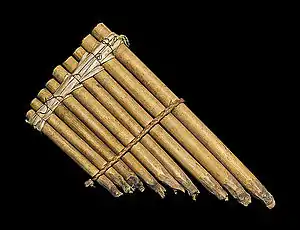
Uncertainty about the best way to delineate and define the region continues to this day. The scholarly consensus now includes New Guinea within Melanesia. Ann Chowning wrote in her 1977 textbook on Melanesia that there is
no general agreement even among anthropologists about the geographical boundaries of Melanesia. Many apply the term only to the smaller islands, excluding New Guinea; Fiji has frequently been treated as an anomalous border region or even assigned wholly to Polynesia; and the people of the Torres Straits Islands are often simply classified as Australian aborigines.[5]:1
In 1998, Paul Sillitoe wrote: "It is not easy to define precisely, on geographical, cultural, biological, or any other grounds, where Melanesia ends and the neighbouring regions ... begins".[6]:1 He ultimately concludes that the region is
a historical category which evolved in the nineteenth century from the discoveries made in the Pacific and has been legitimated by use and further research in the region. It covers populations that have a certain linguistic, biological and cultural affinity – a certain ill-defined sameness, which shades off at its margins into difference.[6]:1
Both Sillitoe and Chowning include the island of New Guinea in the definition of Melanesia, and both of them exclude Australia.
Most of the peoples of Melanesia live either in politically independent countries, or in areas administered by France, or in a country (West Papua) that currently has an active independence movement. Some have recently embraced the term 'Melanesia' as a source of identity and empowerment. Stephanie Lawson writes that the term has "moved from a term of denigration to one of affirmation, providing a positive basis for contemporary subregional identity as well as a formal organisation".[7]:14 The author Bernard Narokobi has written that the concept of the "Melanesian Way" as a distinct cultural force could give the people of the region a sense of empowerment. This concept has in fact been used as a force in geopolitics. For instance, when the countries of Vanuatu, the Solomon Islands, Papua New Guinea, and Fiji reached a regional preferential trade agreement, they named it the Melanesian Spearhead Group.
History
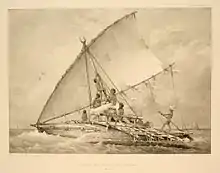
.png.webp)
The people of Melanesia have a distinctive ancestry. According to the Southern Dispersal theory, a number of human beings emigrated from Africa between 50,000 and 100,000 years ago and dispersed along the southern edge of Asia. For some, the endpoint of this ancient migration was the ancient continent of Sahul, a single land mass comprising both the areas that are now Australia and New Guinea. (At that time, they were united by a land bridge, because sea levels were lower than they are now.) The first migration into Sahul was over 40,000 years ago. Some migrants settled in the part that is now New Guinea, while others continued south and became the aboriginal inhabitants of Australia.
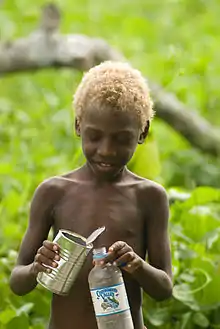
Another wave of Austronesian migrants, probably from Polynesia, arrived in Melanesia much later, probably between 4000 and 3000 BC. They settled mostly along the north coast of New Guinea and on the islands to its north and east.[9][10] When they arrived, they came into contact with the much more ancient indigenous Papuan-speaking peoples. Some late-20th-century scholars developed a theory, known as the “Polynesian theory,” that there then followed a long period of interaction between these newcomers and the pre-existing inhabitants that led to many complex genetic, linguistic, and cultural mixing and other changes among the descendants of all the groups.[11]
This theory was later called into question, however, by the findings of a genetic study published by Temple University in 2008. That study found that neither Polynesians nor Micronesians have much genetic relation to Melanesians. The study's results suggest that, after ancestors of the Polynesians, having developed sailing outrigger canoes, migrated out of East Asia, they moved quickly through the Melanesian area, mostly without settling there, and instead continued on to areas east of Melanesia, finally settling in those areas.
The genetic evidence suggests that they left few descendants in Melanesia, and therefore probably "only intermixed to a very modest degree with the indigenous populations there". The study did find a small Austronesian genetic signature (below 20%) in some of the Melanesian groups who speak Austronesian languages, but found no such signature at all in Papuan-speaking groups.[9][12]
Languages
Most of the languages of Melanesia are members of the Austronesian language family or one of the numerous Papuan languages. The term “Papuan languages” refers to their geographical location rather than implying that they are linguistically related. In fact they comprise many separate language families. By one count, there are 1,319 languages in Melanesia, scattered across a small amount of land. On average, there is one language for every 716 square kilometers on the island. This is by far the densest collection of distinct languages on Earth, almost three times as dense as in Nigeria, a country famous for having a very large number of languages in a very compact area.[13]
In addition to the many indigenous Melanesian languages, pidgins and creole languages have developed from trade and cultural interaction within the area and with the wider world. Most notable among these are Tok Pisin and Hiri Motu in Papua New Guinea. They are now both considered distinct creole languages. Use of Tok Pisin is growing. It is sometimes learned as a first language, above all by multi-cultural families. Examples of other Melanesian creoles are Unserdeutsch, Solomon Islands Pijin, Bislama, and Papuan Malay.
Geography
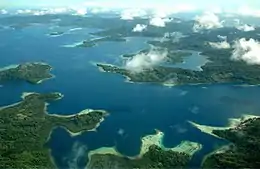
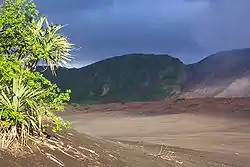
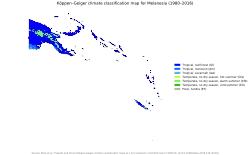
A distinction is often made between the island of New Guinea and what is known as Island Melanesia, which consists of "the chain of archipelagos, islands, atolls, and reefs forming the outer bounds of the sheltered oval-shaped coral sea".[14]:5 This includes the Louisiade Archipelago (a part of Papua New Guinea), the Bismarck Archipelago (a part of Papua New Guinea and Solomon Islands), and the Santa Cruz Islands (a part of the country called Solomon Islands). The country of Vanuatu is composed of the New Hebrides island chain (and in the past 'New Hebrides' has also been the name of the political unit located on the islands). New Caledonia is composed of one large island and several smaller chains, including the Loyalty Islands. The nation of Fiji is composed of two main islands, Viti Levu and Vanua Levu, and smaller islands, including the Lau Islands.
The names of islands in Melanesia can be confusing: they have both indigenous and European names. National boundaries sometimes cut across archipelagos. The names of the political units in the region have changed over time, and sometimes have included geographical terms. For example, the island of Makira was once known as San Cristobal, the name given to it by Spanish explorers. It is in the country Solomon Islands, which is a nation-state and not a contiguous archipelago. The border of Papua New Guinea and Solomon Islands separates the island of Bougainville from nearby islands like Choiseul, although Bougainville is geographically part of the chain of islands that includes Choiseul and much of the Solomons.
In addition to the islands mentioned above, there are many smaller islands and atolls in Melanesia. These include:
- Amphlett Islands, Papua New Guinea
- D'Entrecasteaux Islands, Papua New Guinea
- Norfolk Island, Australia (geographically only)[note 1]
- Raja Ampat Islands, West Papua, Indonesia
- Aru Islands, Maluku, Indonesia (geographically only)
- Rotuma, Fiji
- Schouten Islands, Papua
- Torres Strait Islands, politically divided between Australia and Papua New Guinea
- Trobriand Islands, Papua New Guinea
- Woodlark Island, Papua New Guinea
Norfolk Island, listed above, has archaeological evidence of East Polynesian rather than Melanesian settlement. Rotuma in Fiji has strong affinities culturally and ethnologically to Polynesia.
Political geography
The following countries are considered part of Melanesia:
Melanesia also includes:
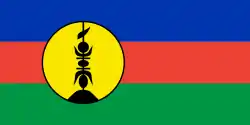 New Caledonia[note 3] – a sui generis collectivity of France.
New Caledonia[note 3] – a sui generis collectivity of France. Papua[note 2] and
Papua[note 2] and .svg.png.webp) West Papua[note 2] – The western half of New Guinea is politically part of
West Papua[note 2] – The western half of New Guinea is politically part of 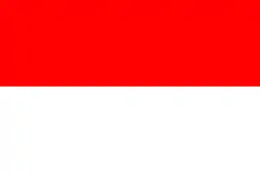 Indonesia. Europeans have always recognized it as geographically part of Melanesia. A rebellion called Free Papua Movement, is active in this area.
Indonesia. Europeans have always recognized it as geographically part of Melanesia. A rebellion called Free Papua Movement, is active in this area.
Several Melanesian states are members of intergovernmental organizations. Papua New Guinea, Solomon Islands, and Vanuatu are members of the Commonwealth of Nations. Fiji, Papua New Guinea, Solomon Islands, and Vanuatu are also members of the Melanesian Spearhead Group.
Genetic studies
Melanesians were found to have a mysterious third archaic Homo species along with their Denisovan (3–4%) and Neanderthal (2%) ancestors in a genetic admixture with their otherwise modern Homo sapiens sapiens genomes.[15] Their most common Y-chromosome haplogroup is M-P256.
The high occurrence of blond hair is due to a specific random mutation, so DNA and phenotype for blonds appeared at least twice in human history.[16]
Notes
- A part of Zealandia geologically. The UN geoscheme includes Norfolk Island in its Australia and New Zealand subregion.
- A part of the Australian continent geologically.
- A part of Zealandia geologically.
See also
- Austronesian peoples
- Denisova hominin
- Melanesian Brotherhood
- Melanesians
- Negrito (of Leyte, Agusan del Norte and Surigao)
- Papuan peoples
- Wallacea
References
- Tcherkezoff, Serge (2003). "A Long and Unfortunate Voyage Toward the Invention of the Melanesia-Polynesia Distinction 1595–1832". Journal of Pacific History. 38 (2): 175–196. doi:10.1080/0022334032000120521. S2CID 219625326.
- "MAPS AND NOTES to illustrate the history of the European 'invention' of the Melanesia / Polynesia distinction". Retrieved 7 March 2013.
- Durmont D'Urville, Jules-Sebastian-Cesar (2003). "On The Islands of The Great Ocean". Journal of Pacific History. 38 (2): 163–174. doi:10.1080/0022334032000120512. S2CID 162374626.
- Codrington, Robert (1915). "Melanesians". Encyclopedia of Religion and Ethics. Edinburgh: T & T Clark. pp. 528–535.
- Chowning, Ann (1977). An Introduction to the Peoples and Cultures of Melanesia. Menlo Park: Cummings Publishing Company.
- Sillitoe, Paul (1998). An Introduction to the Anthropology of Melanesia. New York: Cambridge University Press.
- Lawson, Stephanie (2013). "'Melanesia': The History and Politics of an Idea". Journal of Pacific History. 48 (1): 1–22. doi:10.1080/00223344.2012.760839.
- Chambers, Geoff (2013). "Genetics and the Origins of the Polynesians". eLS. John Wiley & Sons, Inc. doi:10.1002/9780470015902.a0020808.pub2. ISBN 978-0470016176.
- "Genome Scans Show Polynesians Have Little Genetic Relationship to Melanesians", Press Release, Temple University, 17 January 2008, accessed 19 July 2015
- Friedlaender, Jonathan S.; Friedlaender, Françoise R.; Reed, Floyd A.; Kidd, Kenneth K.; Kidd, Judith R.; Chambers, Geoffrey K.; Lea, Rodney A.; Loo, Jun-Hun; Koki, George (2008-01-18). "The Genetic Structure of Pacific Islanders". PLOS Genetics. 4 (1): e19. doi:10.1371/journal.pgen.0040019. ISSN 1553-7404. PMC 2211537. PMID 18208337.
- Spriggs, Matthew (1997). The Island Melanesians. Blackwell. ISBN 978-0-631-16727-3.
- Friedlaender J, Friedlaender FR, Reed FA, Kidd KK, Kidd JR (2008-01-18). "The Genetic Structure of Pacific Islanders". PLOS Genetics. 4 (3): e19. doi:10.1371/journal.pgen.0040019. PMC 2211537. PMID 18208337.
- Landweer, M. Lynn; Unseth, Peter (2012). "An introduction to language use in Melanesia". International Journal of the Sociology of Language. 2012 (214): 1–3. doi:10.1515/ijsl-2012-0017. S2CID 146952244.
- Moore, Clive (2003). New Guinea: Crossing Boundaries and History. Honolulu: University of Hawaii Press.
- Melanesians reveal archaic admixture in modern humans
- The Origin of Blond Afros in Melanesia
External links
| Wikimedia Commons has media related to Melanesia. |
- UNSD Methodology – Standard country or area codes for statistical use (M49)
- Polynesian origins: Insights from the Y chromosome
- Independent Histories of Human Y Chromosomes from Melanesia and Australia
- Bird checklists for Melanesian islands
- Anglican historical texts related to Melanesia
- Ancient humans, dubbed 'Denisovans', interbred with us BBC News online (2010-12-22) report (with video) on study that shows that Denisovans interbred with the ancestors of the present-day people of the Melanesian region north and north-east of Australia. Melanesian DNA comprises between 4% and 6% Denisovan DNA.
- Long strand of DNA from Neanderthals found in people from Melanesia Science_(journal) (2018-10-18) RESEARCH ARTICLE Adaptive archaic introgression of copy number variants and the discovery of previously unknown human genes.
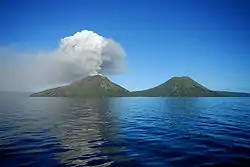

.svg.png.webp)
